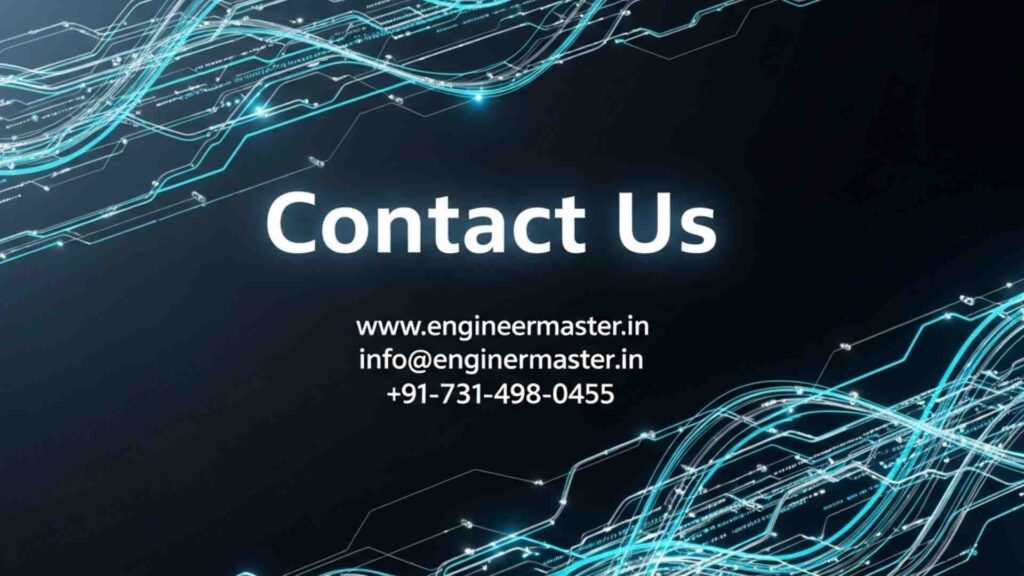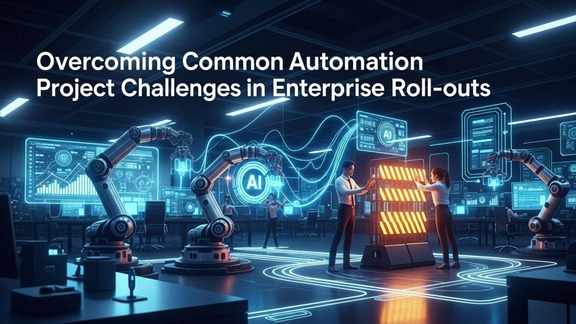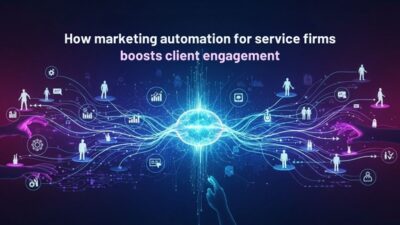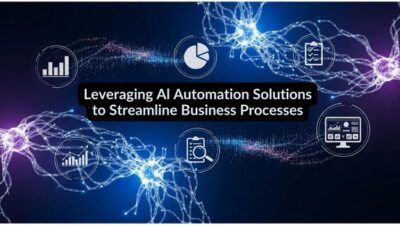Introduction
TL;DR Enterprise automation initiatives promise transformative efficiency gains. Executives envision streamlined workflows and substantial cost reductions. Vendors demonstrate impressive capabilities during sales presentations. Project teams launch with optimism and ambitious timelines.
Reality hits hard during implementation. Unexpected technical obstacles emerge constantly. Employee resistance derails carefully planned rollouts. Integration complexities multiply beyond initial estimates. Budgets balloon while timelines stretch indefinitely.
Most automation projects fail to deliver promised value. Studies show 30% to 50% of initiatives never reach full production. Those that launch often underperform expectations significantly. Organizations waste millions on abandoned or underutilized automation.
Understanding automation project challenges helps enterprises avoid common pitfalls. The obstacles fall into predictable patterns across industries. Successful organizations anticipate these issues and plan accordingly. Preparation transforms potential disasters into manageable hurdles.
This comprehensive guide explores the most frequent implementation obstacles. You’ll discover practical strategies that leading enterprises use successfully. Real-world examples illustrate effective problem-solving approaches. Your automation initiatives gain higher success probability through shared learning.
The stakes for getting automation right continue rising. Competitors leverage technology to reduce costs dramatically. Customer expectations demand faster service delivery. Market dynamics punish operational inefficiency ruthlessly. Your organization must overcome automation project challenges to remain competitive.
Table of Contents
Understanding Why Automation Projects Fail
Unrealistic expectations doom projects from inception. Vendors oversell capabilities during procurement processes. Business cases rely on optimistic assumptions. Reality rarely matches idealized scenarios presented initially.
Poor process understanding creates fundamental problems. Teams automate broken workflows without fixing them first. Inefficiencies get embedded into automated systems permanently. Technology amplifies existing problems rather than solving them.
Insufficient stakeholder engagement undermines adoption. End users learn about automation after decisions get made. Their concerns and insights never inform design choices. Resistance builds because people feel automation happens to them rather than for them.
Technical complexity exceeds organizational capability. Legacy systems lack necessary integration points. Custom development requirements multiply unexpectedly. Internal IT teams lack expertise in automation platforms.
Change management gets neglected or treated superficially. Organizations focus entirely on technology implementation. They ignore human factors determining success or failure. Adoption falters because people aren’t prepared for changes.
Resource constraints limit project success potential. Inadequate budgets create corner-cutting temptations. Timeline pressure forces rushed decisions. Team members juggle automation work with regular responsibilities.
Governance gaps allow scope creep and misalignment. Nobody clearly owns automation strategy across enterprise. Different departments pursue conflicting initiatives. Duplication and incompatibility result from uncoordinated efforts.
Common Automation Project Challenges in Planning Phase
Scope definition challenges create confusion and conflict. Stakeholders hold different expectations about automation extent. Requirements gathering captures surface needs but misses deeper issues. The project tries to solve everything simultaneously.
Business case weaknesses undermine executive support. ROI calculations rely on questionable assumptions. Implementation costs get underestimated systematically. Benefit timelines prove overly optimistic consistently.
Technology selection mistakes lock in future problems. Evaluation criteria emphasize features over fit. Vendor promises influence decisions more than reference checks. Scalability and integration get insufficient consideration.
Process documentation proves incomplete or inaccurate. Current state understanding relies on assumptions. Exception scenarios and edge cases go undocumented. The automation design misses critical workflow realities.
Team composition lacks necessary skill diversity. Projects overweight technical skills and underweight business knowledge. Change management expertise gets excluded entirely. Subject matter experts have insufficient time allocation.
Timeline development ignores predictable delays. Planning assumes everything proceeds perfectly. Buffer time for unexpected issues doesn’t exist. Dependencies between activities get oversimplified.
Budget allocation fails to cover full costs. Software licensing represents only fraction of total expense. Implementation services get underestimated dramatically. Ongoing support and maintenance receive inadequate funding.
Technical Automation Project Challenges
System integration complexity exceeds initial assessment. Legacy platforms lack modern APIs. Data formats require extensive transformation. Real-time synchronization proves more difficult than expected.
Data quality issues corrupt automation processes. Inconsistent formats cause validation failures. Missing information triggers exception handling constantly. Duplicate records create processing errors and confusion.
Scalability limitations emerge under production loads. Pilot performance doesn’t predict enterprise volume handling. Response times degrade as usage increases. Infrastructure capacity requires expensive upgrades.
Security vulnerabilities create compliance risks. Automation tools access sensitive data across systems. Authentication and authorization require careful implementation. Audit trail requirements demand additional development.
Error handling proves inadequate for real scenarios. Happy path testing misses common failure modes. Exception processing logic becomes overwhelming complex. User experience suffers when errors occur.
Performance bottlenecks appear in unexpected places. Network latency impacts process completion times. Database queries slow under concurrent usage. Third-party API rate limits constrain throughput.
Platform limitations require workarounds. Vendor capabilities don’t match specific requirements exactly. Customization needs exceed platform flexibility. Workarounds create technical debt and maintenance burdens.
Organizational Automation Project Challenges
Employee resistance manifests in multiple forms. Open opposition comes from those fearing job loss. Passive resistance shows through non-cooperation and workarounds. Skepticism spreads when early results disappoint.
Siloed thinking prevents enterprise coordination. Departments optimize locally rather than globally. They resist sharing resources or standardizing approaches. Competition replaces collaboration across business units.
Leadership commitment wavers when challenges emerge. Initial enthusiasm fades during difficult implementation periods. Competing priorities divert executive attention elsewhere. Budget cuts threaten projects mid-stream.
Skills gaps limit internal capability development. Existing staff lack automation expertise. Training programs can’t keep pace with need. Hiring qualified talent proves difficult and expensive.
Process ownership ambiguity creates accountability gaps. Nobody clearly owns end-to-end processes. Multiple stakeholders each control different segments. Coordination becomes impossible without clear ownership.
Communication breakdowns occur across project lifecycle. Technical teams and business users speak different languages. Status updates fail to convey true project health. Issues surface too late for effective intervention.
Cultural barriers impede change acceptance. Risk-averse cultures resist process changes. Perfectionism delays deployment indefinitely. Innovation gets stifled by bureaucratic approval processes.
Strategic Solutions for Planning Challenges
Phased approaches reduce risk and build momentum. Start with manageable pilot projects showing quick value. Expand scope gradually based on learning and success. Bite-sized chunks prevent overwhelming the organization.
Realistic goal-setting aligns expectations with reality. Conservative ROI estimates under-promise and over-deliver. Honest timeline development includes buffer for issues. Transparency about challenges builds credibility.
Comprehensive process analysis happens before automation begins. Teams document current state thoroughly and honestly. They identify root causes of inefficiencies. Process improvement happens before automation deployment.
Cross-functional team composition ensures diverse perspectives. Business users guide requirements and priorities. Technical experts assess feasibility and design solutions. Change management specialists plan adoption strategies.
Executive sponsorship goes beyond token support. Leaders actively remove obstacles and resolve conflicts. They communicate importance consistently across organization. Resources get protected from competing demands.
Vendor evaluation prioritizes long-term partnership potential. References from similar organizations carry heavy weight. Proof-of-concept testing validates capabilities with your data. Total cost of ownership gets calculated comprehensively.
Governance structures coordinate automation enterprise-wide. Center of excellence shares best practices and standards. Architecture review ensures integration and scalability. Portfolio management prioritizes initiatives strategically.
Technical Solutions for Integration Issues
API-first architecture enables flexible integration. Modern interfaces support multiple integration patterns. Versioning allows changes without breaking connections. Documentation facilitates developer productivity.
Middleware platforms bridge legacy and modern systems. Enterprise service buses route data between applications. Integration platform as a service reduces custom coding. Pre-built connectors accelerate common integrations.
Data quality initiatives clean information at source. Validation rules prevent bad data entry. Master data management creates single sources of truth. Regular audits identify and correct quality issues.
Robust error handling recovers gracefully from failures. Retry logic handles transient issues automatically. Detailed logging aids troubleshooting and resolution. User-friendly error messages guide corrective action.
Performance testing validates scalability before production. Load testing simulates realistic usage volumes. Bottleneck analysis identifies limiting factors. Optimization happens based on measured results.
Security frameworks protect throughout automation lifecycle. Role-based access controls limit data exposure. Encryption protects sensitive information. Regular security assessments identify vulnerabilities.
Modular design enables incremental deployment and maintenance. Components handle discrete functions independently. Interfaces between modules remain clean and well-defined. Changes impact limited system areas.
Overcoming Automation Project Challenges Through Change Management
Early stakeholder involvement builds buy-in and ownership. Engage end users during requirements gathering. Incorporate their feedback into design decisions. Create champions who advocate for adoption.
Transparent communication addresses concerns proactively. Explain automation rationale and expected impacts honestly. Acknowledge job change fears rather than dismissing them. Share progress and setbacks candidly throughout project.
Comprehensive training prepares people for new workflows. Hands-on practice builds confidence before go-live. Job aids support users during transition period. Ongoing education addresses emerging needs.
Impact analysis identifies affected individuals and groups. Understand how automation changes daily work. Anticipate emotional responses to changes. Plan mitigation strategies for negative impacts.
Incentive alignment motivates desired behaviors. Recognize and reward automation adoption. Tie performance metrics to new processes. Remove penalties for automation-related learning curves.
Pilot groups test automation with forgiving audiences. Select enthusiastic early adopters for initial rollout. Learn from their experiences before broader deployment. Success stories build momentum for expansion.
Feedback mechanisms capture user experience insights. Surveys and interviews reveal adoption obstacles. Analytics show actual usage versus intended. Continuous improvement responds to user input.
Measuring Success and Adjusting Course
Key performance indicators track progress objectively. Efficiency metrics show productivity improvements. Quality measures reveal error rate changes. User adoption rates indicate change acceptance.
Baseline measurements establish comparison points. Document current state before automation begins. Measure same metrics consistently post-implementation. Data-driven evaluation replaces subjective assessment.
Benefit realization tracking validates business case. Compare actual results against promised outcomes. Identify where expectations weren’t met and why. Adjust forecasts based on real performance data.
Regular project health assessments catch problems early. Status reporting uses consistent frameworks and formats. Risk registers document threats and mitigation plans. Steering committees review progress and make decisions.
User satisfaction surveys gauge experience quality. Measure ease of use and perceived value. Track support ticket volume and resolution times. Satisfaction predicts long-term adoption success.
Post-implementation reviews capture lessons learned. Document what worked well and what didn’t. Identify root causes of challenges encountered. Share knowledge across enterprise for future projects.
Continuous improvement cycles enhance automation value. Monitor performance metrics for degradation signs. Gather enhancement requests from user community. Prioritize improvements based on impact potential.
Industry-Specific Automation Project Challenges
Manufacturing faces legacy equipment integration issues. Operational technology uses proprietary protocols. Real-time control requirements demand low latency. Safety systems require extensive validation and certification.
Healthcare encounters strict regulatory compliance demands. HIPAA requirements complicate data handling. Clinical workflow interruptions risk patient safety. Medical staff resistance to technology changes runs high.
Financial services navigate complex security requirements. Fraud detection systems need constant updating. Transaction processing requires perfect accuracy. Regulatory reporting demands comprehensive audit trails.
Retail struggles with peak season scalability needs. Holiday volumes exceed normal capacity by multiples. Inventory management spans complex supply chains. Customer-facing processes require high reliability.
Government entities deal with bureaucratic approval processes. Procurement regulations slow technology acquisition. Budget cycles don’t align with project timelines. Public scrutiny limits risk tolerance severely.
Telecommunications manages massive transaction volumes. Network operations require 24/7 availability. Customer data privacy regulations vary by jurisdiction. Technical complexity spans multiple technology layers.
Building Organizational Automation Capability
Centers of excellence establish standards and share knowledge. They develop reusable components and templates. Best practices get documented and disseminated. Common mistakes get avoided through shared learning.
Training programs develop internal expertise. Technical skills courses create automation developers. Business analysis training improves requirements gathering. Change management education prepares project leaders.
Partnership strategies augment internal capabilities. System integrators provide implementation expertise. Managed service providers handle ongoing operations. Training vendors accelerate skill development.
Agile methodologies enable faster value delivery. Iterative development shows progress incrementally. Regular feedback loops guide refinement. Course corrections happen quickly based on learning.
DevOps practices accelerate deployment and maintenance. Continuous integration catches issues early. Automated testing ensures quality without slowing speed. Infrastructure as code enables rapid environment provisioning.
Knowledge management preserves organizational learning. Documentation repositories store technical and process information. Collaboration platforms facilitate knowledge sharing. Lessons learned databases prevent repeating mistakes.
Innovation programs encourage experimentation. Hackathons generate creative automation ideas. Pilot budgets enable low-risk testing. Failure tolerance creates safe environment for learning.
Future-Proofing Your Automation Investment
Platform evaluation considers long-term viability. Vendor financial stability matters for ongoing support. Technology roadmaps align with your strategic direction. Migration paths exist if platform changes become necessary.
Architecture flexibility accommodates future changes. Loosely coupled components adapt to new requirements. Standard interfaces simplify technology substitution. Cloud-native designs leverage modern infrastructure.
Skills development maintains internal capability. Training keeps pace with platform evolution. Career paths attract and retain automation talent. Knowledge transfer prevents key person dependencies.
Governance evolution matches organizational maturity. Light governance early avoids bureaucratic overhead. Structure increases as automation portfolio grows. Balance control with agility appropriately.
Scalability planning anticipates growth needs. Infrastructure capacity exceeds current requirements. Licensing models accommodate usage expansion. Performance remains acceptable as volumes increase.
Security evolution addresses emerging threats. Regular assessments identify new vulnerabilities. Patches and updates apply systematically. Threat intelligence informs protective measures.
Continuous innovation adoption maintains competitiveness. Evaluate new automation capabilities regularly. Pilot emerging technologies with contained risk. Modernize proactively rather than reactively.
Frequently Asked Questions
What are the most common automation project challenges?
The most frequent automation project challenges include unclear requirements and scope creep. Poor process understanding leads to automating broken workflows. Technical integration complexity exceeds initial estimates regularly. Employee resistance undermines adoption despite perfect implementation. Budget overruns happen from underestimating true costs. Timeline delays result from optimistic planning assumptions. Inadequate change management causes project failures. These challenges appear consistently across industries and organization sizes.
How can we prevent scope creep in automation projects?
Prevent scope creep through rigorous change control processes. Document requirements comprehensively during planning phase. Establish formal approval process for scope additions. Assess impact of changes on timeline and budget. Communicate consequences of scope expansion transparently. Prioritize ruthlessly based on value and feasibility. Save nice-to-have features for future phases. Governance committees enforce discipline around scope management. Clear requirements and strong governance prevent most scope creep.
What role does change management play in automation success?
Change management determines automation project success as much as technology does. People resistance kills perfectly designed automation systems. Early stakeholder involvement builds ownership and buy-in. Transparent communication addresses fears and concerns proactively. Comprehensive training prepares users for new workflows. Impact analysis identifies and mitigates negative consequences. Feedback mechanisms enable continuous improvement. Organizations neglecting change management typically fail regardless of technical excellence.
How long should enterprise automation projects take?
Project duration varies dramatically by scope and complexity. Pilot projects typically complete in three to six months. Department-wide implementations require six to twelve months. Enterprise rollouts often span twelve to twenty-four months. Rushing timelines increases failure risk substantially. Phased approaches deliver value incrementally over time. Buffer time for unexpected challenges proves essential. Realistic timelines based on similar project experience work best.
What budget should we allocate for automation?
Budget requirements depend on automation scope and platform choice. Software licensing represents 20% to 40% of total cost. Implementation services consume 30% to 50% of budget. Internal resource costs add another 20% to 30%. Ongoing support and maintenance require 15% to 20% annually. Initial projects cost more per process than later ones. Plan for 20% to 30% budget contingency. Total cost of ownership over three years provides realistic view.
How do we measure automation project success?
Measure success through multiple quantitative and qualitative metrics. Efficiency gains show in reduced processing times. Cost savings appear in decreased labor requirements. Quality improvements manifest through lower error rates. User satisfaction surveys gauge adoption and experience. Business case validation compares actual to promised benefits. Adoption metrics show percentage of transactions automated. Regular measurement throughout project lifecycle enables course correction.
Should we build or buy automation capabilities?
Build versus buy depends on specific requirements and capabilities. Standard processes favor commercial platforms with proven capabilities. Unique requirements may need custom development. Consider total cost of ownership over long term. Evaluate internal development and maintenance capabilities honestly. Time to value often favors commercial solutions. Hybrid approaches use platforms plus targeted customization. Strategic decisions require comprehensive analysis.
How do we handle employee resistance to automation?
Address resistance through transparent communication and involvement. Explain automation rationale and expected impacts honestly. Acknowledge job change concerns rather than dismissing them. Involve employees in design and testing. Provide comprehensive training and support. Create career development paths incorporating automation. Recognize and reward adoption and innovation. Resistance decreases when people see automation as empowerment rather than threat.
Read more:-Improving Customer Engagement Through Marketing Automation for Service Firms
Conclusion

Automation project challenges appear consistently across enterprise implementations. Technical integration complexities exceed initial estimates regularly. Organizational resistance undermines adoption despite perfect technical execution. Budget and timeline overruns plague majority of initiatives.
Understanding common obstacles enables proactive mitigation. Careful planning addresses predictable challenges before they occur. Phased approaches reduce risk and build organizational capability. Realistic expectations align stakeholders around achievable goals.
Change management determines success as much as technology selection. Early stakeholder involvement builds ownership and support. Transparent communication addresses concerns before they become obstacles. Comprehensive training prepares people for workflow changes.
Technical excellence alone cannot guarantee automation success. Integration architecture must span legacy and modern systems. Data quality requires attention before and during automation. Performance testing validates scalability before production deployment.
Measuring progress through objective metrics enables course correction. Baseline measurements establish comparison points for improvement. Regular assessment catches problems while mitigation remains possible. Benefit realization tracking validates business case assumptions.
Building organizational capability creates sustainable competitive advantage. Centers of excellence share knowledge and establish standards. Training programs develop internal expertise systematically. Partnership strategies augment internal capabilities strategically.
Starting small and scaling deliberately works better than big bang approaches. Pilot projects prove concepts with manageable risk. Success builds confidence and capability for larger initiatives. Incremental value delivery maintains executive support through challenges.
Governance structures coordinate automation across enterprise. They prevent duplicate efforts and incompatible implementations. Architecture standards ensure integration and scalability. Portfolio management prioritizes initiatives strategically.
Future-proofing investments protects against technology changes. Platform flexibility accommodates evolving requirements. Skills development maintains internal capability over time. Continuous innovation adoption maintains competitive position.
The competitive imperative for automation continues intensifying. Market dynamics punish operational inefficiency ruthlessly. Customer expectations demand faster service delivery. Technology costs decrease while benefits increase steadily.
Your organization can overcome automation project challenges successfully. Apply lessons learned from others who succeeded. Anticipate predictable obstacles and plan accordingly. Execute with discipline and flexibility simultaneously.
Start your next automation initiative with eyes wide open. Acknowledge challenges honestly during planning phase. Allocate sufficient resources for comprehensive implementation. Prioritize change management alongside technical execution.
Success requires persistence through inevitable difficulties. Challenges will emerge despite best planning. Learn quickly and adjust course based on experience. Maintain focus on business outcomes throughout journey.
The automation opportunity remains compelling despite implementation challenges. Organizations mastering execution gain sustainable advantages. Those overcoming automation project challenges thrive while others struggle. Your competitive position depends on implementation excellence.





